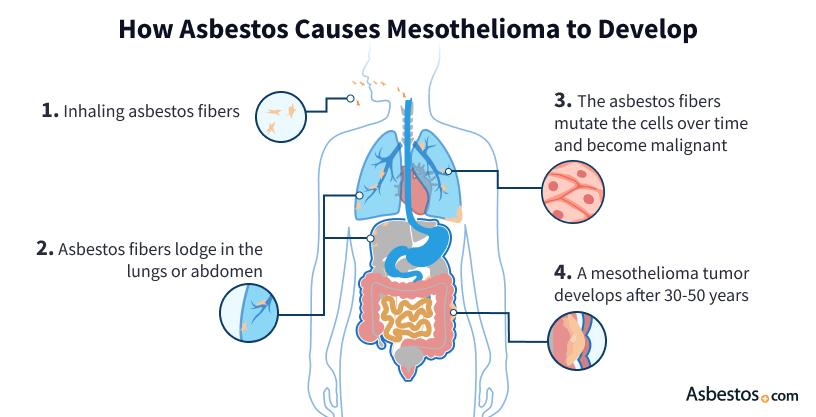John Conway worked as a Navy boiler technician when ships heavily used asbestos. He then worked for the Merchant Marines for 24 years. “I was proud to serve. It was fun, too. It took me around the world three times,” he shares with us.
Mesothelioma Causes & Risk Factors
The primary cause of mesothelioma is asbestos. The asbestos fibers stick to the lining of the lungs and other organs, eventually causing mesothelioma. The main mesothelioma risk factor is asbestos exposure. Other risk factors for mesothelioma are occupational and secondhand exposure, age and gender.
What Causes Mesothelioma?
The primary cause of mesothelioma is asbestos. When people inhale or swallow asbestos fibers, they can lodge in the lining of the lungs, abdomen, heart or testes. Over time, the trapped fibers irritate these tissues and may lead to mesothelioma.
Learn about your diagnosis, top doctors and how to pay for treatment.
Get Your Free GuideKey Facts About Mesothelioma Causes
- Out of all people with heavy, prolonged exposure to asbestos, 8% to 13% develop mesothelioma.
- Workers exposed to asbestos for many years face the greatest risk of mesothelioma.
- The main mesothelioma risk factor is asbestos exposure. Other risk factors for mesothelioma are occupational and secondhand exposure, age and gender.
Most mesothelioma cases come from asbestos exposure at work or in the military. Some people develop mesothelioma from secondhand contact. Workers have accidentally carried asbestos home on their bodies, clothes or gear. This has put their families at risk.
Other risk factors can raise the chance of cancer in those exposed to asbestos. Doctors have researched other potential causes and risk factors. Some of these possible causes include genetics and exposure to radiation.
How Asbestos Causes Mesothelioma Cancer
Mesothelioma cancer develops after asbestos fibers get stuck in the mesothelium and cause irritation over time. This leads to inflammation and scarring. These fibers can make unstable tiny particles called free radicals that can damage DNA, causing cells to become cancerous.
The duration and intensity of asbestos exposure impact how much DNA damage occurs. More exposure means a greater risk of getting mesothelioma. This is called a dose-response relationship. Even one heavy exposure can lead to a mesothelioma cancer diagnosis decades later. For example, the toxic dust cloud from the 9/11 attack in New York exposed many people to a single instance of a large volume of asbestos. Many of these people, including first responders, developed mesothelioma.

What Are the Risk Factors for Mesothelioma?
The main risk factor for mesothelioma is asbestos exposure. Risk factors are characteristics or behaviors that raise the chances of getting a specific disease. Other risk factors include genetics, age, gender and other types of exposure.
Mesothelioma Risk Factors Include
Exposure to asbestos can happen at work, in older homes, in public buildings and in the environment. Asbestos fibers make products heat resistant. But they can break down and create toxic dust. Workers in commercial and industrial sectors faced a high risk of exposure.
Pleural mesothelioma survivor Terry Latham’s asbestos exposure happened during 10 years of construction work. Decades later, Terry told us received his diagnosis. Now, he’s one of the longest-living pleural survivors. “People should know you can get through it, but you can’t stop fighting, ” Terry tells us. “Whatever you do, don’t give up.”

Find the top cancer centers trusted by mesothelioma patients nationwide.
Get Help NowOccupational Asbestos Exposure
Occupational asbestos exposure is the No. 1 cause of mesothelioma. Miners and industrial workers faced a high risk. Shipyard, boiler and power plant workers were also at risk. Legacy asbestos in older buildings remains a concern.
Construction workers and firefighters are also at risk of encountering legacy asbestos. The risk is high during renovation, demolition or disaster response. Auto mechanics still work with asbestos parts like brakes and clutches.
Military Asbestos Exposure
Veterans get mesothelioma from military asbestos exposure. The military used asbestos in bases, vehicles, ships and planes. Navy personnel faced higher risks of exposure. Asbestos was used on ships because it reduced the spread of fire. Boiler workers, pipefitters and shipyard workers used asbestos products a lot.
Navy veteran John Conway remembers stripping asbestos insulation as part of his job. Decades later, John told us he developed pleural mesothelioma. “It used to look like it was snowing down there,” John recalls about the airborne asbestos fibers he witnessed.
Secondary Asbestos Exposure
Secondary exposure occurs when a person brings asbestos fibers home. The fibers get carried on their skin, hair, clothing, footwear or tools. Those fibers can spread into the air, too. This puts nearby people at risk of exposure. For example, barbers and ceramics workers used talcum powder with asbestos in it. Taking these fibers home raised the risk of cancer among family members.
My mesothelioma was caused by my father’s work clothes. He had been a lagger and worked with asbestos all through my childhood. He died of mesothelioma in 1989.
Environmental Asbestos Exposure
Living near asbestos deposits risks exposure. Tiny fibers can stay in the air in these areas. It’s most dangerous near old asbestos mines and factories. Asbestiform minerals, like eronite, form long, thin fibers. Because of this, eronite deposits also present a risk.
The risk of disease from living near asbestos mines is lower than from working with asbestos. Research shows this might lead to 3% of all mesothelioma cases. For women, the number jumps to 19%.
Age and Gender Risk for Mesothelioma
Men are more likely than women to develop mesothelioma. Mesothelioma incidence rates show it occurred 2.4 times more often in men than in women in 2020. This is the most recent data from the CDC and SEER. The CDC also recently reported a sharp rise in mesothelioma cases in women.
Another CDC report from 2020, showed that most people get diagnosed between ages 75 and 79. Risk increases with age because mesothelioma takes 20 to 60 years to develop after exposure. But this doesn’t mean young people don’t get mesothelioma from asbestos exposure. Asbestos-related mesothelioma has been found in teens and young adults in their 20s.
One piece of advice who I would give to a woman who has been recently diagnosed with mesothelioma is this. Let me encourage you for a moment. You have access to treatments, different treatments. You have the right to get a second opinion. You have the right to ask questions. You have the right to find the specialist who you want for your journey.
Family History and BAP1 Gene
Genetic factors can raise the risk of mesothelioma after asbestos exposure. Mesothelioma isn’t inherited. But a person with a BAP1 mutation faces a higher risk of illness from asbestos exposure.
Gene mutations are variations of the typical DNA in a gene. Mutations of a gene called BAP1 can exist in mesothelioma cells. This is why the 2025 American Society of Clinical Oncology mesothelioma guidelines now recommend genetic testing as part of the diagnostic process.
Simian Virus 40 & Radiation
Exposure to high doses of radiation may be a risk factor for mesothelioma. Low doses of radiation from X-rays, CT scans and occupational exposure aren’t risk factors.
SV40 isn’t known to cause mesothelioma. However, many cases show SV40 in cancer cells. Research is ongoing to determine if it’s a risk factor for mesothelioma.
How Can You Lower Your Risk of Mesothelioma?
The best way to lower your risk of mesothelioma is to avoid asbestos exposure. Employers must provide safe working conditions to prevent mesothelioma. They must ensure their workplaces are free of asbestos. Workers can follow protocols for their own safety, like using personal protective gear. If they see violations they can speak with their union reps or file a report with the Occupational Safety and Health Administration.
The public can also protect themselves from asbestos products in consumer items, in their homes or when doing DIY automotive work. Learning how to avoid asbestos products can reduce the risk of exposure.
Tips to Reduce Asbestos Exposure
- Avoid wearing clothing, footwear and other work gear that could carry asbestos fibers home.
- Be careful when buying vintage, antique or upcycled items that may contain asbestos.
- Choose a reliable asbestos abatement company. They can test and remove asbestos from your home.
- Purchase talc-free cosmetics and personal care items.
- Report asbestos exposure at work to OSHA.
- Talk to your employer about asbestos risks and the policies in place to mitigate those risks.
If you’ve already been exposed and are concerned about your health, our Patient Advocates can help you. They can connect you with a doctor to screen for mesothelioma. Catching the disease early improves treatment outcomes.
Visit your doctor right away if you have symptoms of mesothelioma. Early signs of mesothelioma are shortness of breath, chest pain or stomach issues. Patient Advocates can connect you with a specialist who offers specialized treatment.
- A 2023 study in the journal Critical Reviews in Toxicology finds risks across jobs and asbestos types. The peritoneal mesothelioma rate for all jobs studied was 70 to several hundred fold higher for amosite and crocidolite.
- Patients and families should be aware of potential asbestos exposure risks, particularly in industries like textile work, construction, manufacturing and shipbuilding.
“Asbestos exposure is the primary cause of mesothelioma. Still, there is no predictability as to who or when the exposure will progress to the development of mesothelioma and where it will manifest in the body.”
Questions Our Patients Advocates Are Commonly Asked
We asked our Patient Advocates about the questions people ask when they call us about the cause of mesothelioma. Here are some common questions and helpful answers.
- How much exposure to asbestos will cause mesothelioma?
-
Most people with asbestos exposure will never develop mesothelioma. However, any asbestos exposure can cause mesothelioma. Chronic exposure carries the highest risk, but even a single exposure can lead to mesothelioma.
- How likely am I to develop mesothelioma?
-
Mesothelioma is a rare form of cancer. There were about 2,800 new cases in the U.S. in 2021, the most recent year of available data. There is about 1 new case per 100,000 people annually. Mesothelioma is very rare in people without any known asbestos exposure. High-risk occupations for asbestos exposure include construction, power generation, shipbuilding and industrial work.
- How long does it take for mesothelioma to develop?
-
Asbestos can change healthy cells into cancer cells decades after exposure. The fibers start an inflammation that slowly harms genes and can lead to cancer 20 to 60 years later. After tumors form, mesothelioma can swiftly advance to stage 3 or 4. Symptoms may appear after this progression.
- Does smoking cause mesothelioma?
-
No, smoking does not cause mesothelioma. The primary cause of mesothelioma is exposure to asbestos fibers. Smoking and tobacco use are linked to lung cancer and other cancers. But they are not linked to a higher risk of mesothelioma.
Answered By: Anna Nowak, internationally renowned asbestos researcher and mesothelioma advocate.







